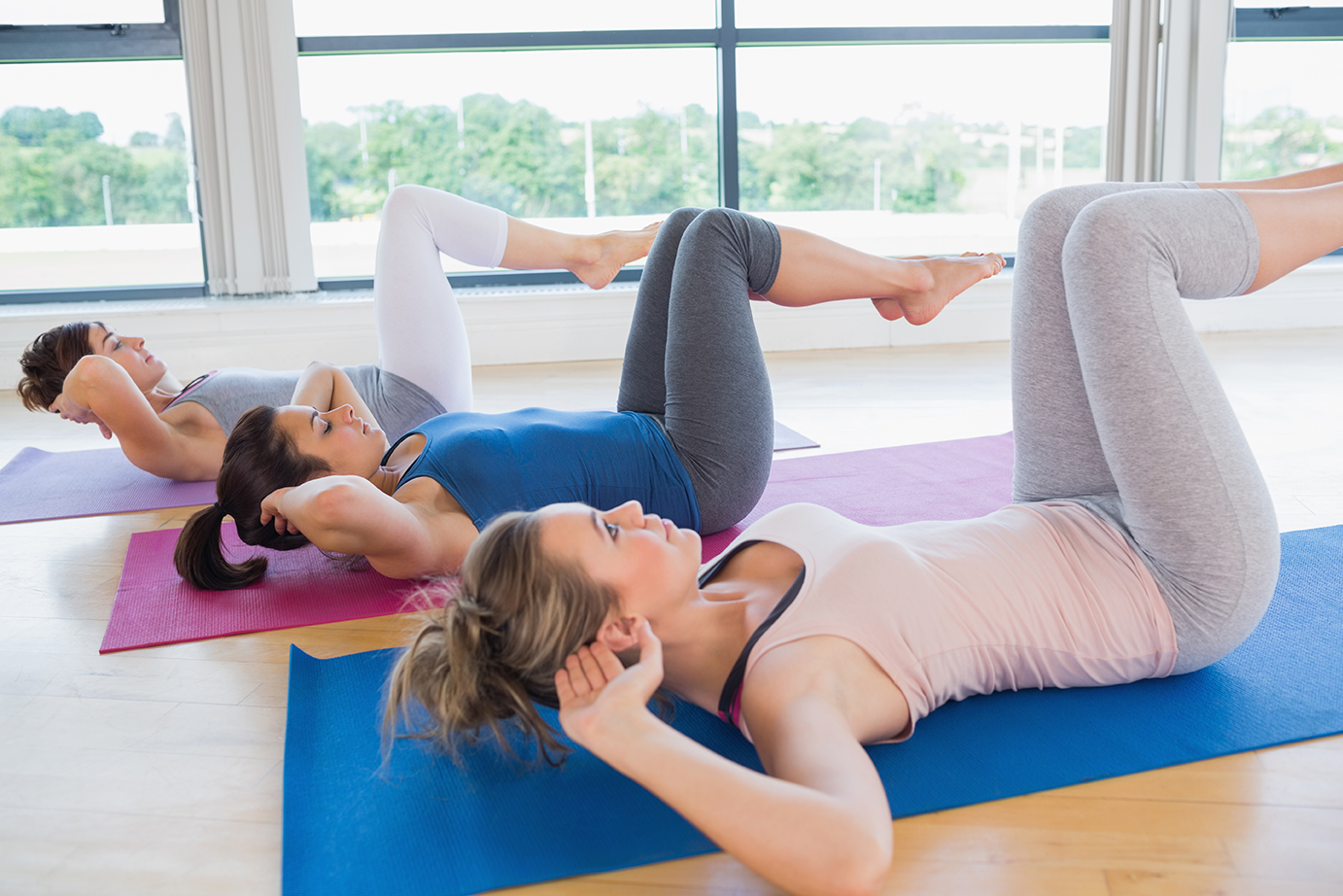Core Exercise, Part 2: Training The Abs To Do Their Job
In a previous blog, Core Exercise, Part 1: Fad, Fashion or Fundamental?, I proposed that core exercise is not just about training the abs since the core is a more integrated, comprehensive functional unit that simply includes the abs as one element. In Part 2, I want to stress how the abs actually function – not based on EMGs or ultrasounds – in doing movements we train with in the gym that correspond to real life.
Motivated by an article in Women’s Health, “17 Back Exercises Every Woman Should Add to Her Workout ASAP“, I was pleasantly pleased to see exercises listed with a by-line that said “It’s not all about the abs, you guys”. The thrust of the article and exercises was that the back is important, too. I’d add that the back is MOST important and that anything you do to strengthen the back, especially with some of the unilateral exercises described, is even BETTER for the abs than crunches.
While some of the exercises were simply simple adaptations of traditional exercises, such as the overhand and underhand bent over row, or were clearly aimed at the anterior core – the abs – they highlight the message I often bring to my sessions with clients.
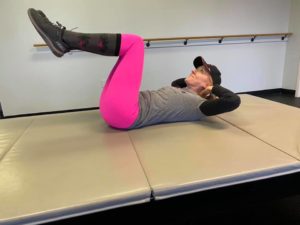
AS A PERSONAL FITNESS TRAINER, IT’S MY GOAL TO PROVIDE SAFE AND EFFECTIVE EXERCISES THAT ENHANCE A PERSON’S HEALTH, WELLNESS, AND FUNCTION.
With this mission statement, first and foremost in my mind when I approach a training session with whomever at whatever stage of health or fitness they are in, my goal is to train them to move and perform ADLs or recreational activities with less strain and stress to their bodies. Especially their spines!
Recognizing that many come in wishing to do something about their guts, I comply with some abs-specific exercises when they are ready for them. But first I aim to train the core as I defined it in the Part 1 blog.
Let’s, for now, leave out of consideration the person with a low back issue such as a ruptured disk or chronic low back pain (LBP). These kinds of issues require gentle step-by-step approaches akin to physical therapy-type exercises before venturing into real-life functional exercises just to get the core working. Which leads me to my framework for working the core, but really any muscle.
There are 5 layers to muscle function:
- activation
- endurance
- strength
- power
- speed
Activation is a neuromuscular bioelectrical event whereby an exercise causes muscles to engage – that is, to fire – so that they learn or re-learn how to do what they were supposed to do. Imagine a stroke victim unable to move a toe. It is the essence of core stabilization. If therapists can get the person’s focus on moving the toe, and the toe actually moves again, that means nerve signals went from the brain down the spine and into the legs all the way to the toe. When the muscle receives those signals, even though it’s been weakened by the stroke itself, it starts to twitch. When the twitch becomes large enough, it fires enough fibers to make the toe move… even a little.
When it comes to core exercise, first we want the muscles to get engaged, to fire, but not to generate movement – that is, to first do an isometric hold. So, for example, taking the bent over row as a case in point, by bending over, with both feet on the floor and one hand supported on a bench or chair, the other holding a weight, the core engages to prevent rotation toward the side that holds the weight. In other words, almost every muscle of the core is activated even as you focus on bringing the weight toward the ribs. Take the support arm away and now the core is super-activated as it now has to support the upper torso plus the weight(s). It’s not a back exercise anymore, it’s a total core exercise as even the abs engage to stiffen the spine against the pulls of gravity and of the lumbar erectors.
Endurance is the next phase of training. This doesn’t mean simply running for miles on end. It means that a muscle can be activated and engaged for longer periods of time than simply to make any particular movement. This entails multiple repetitions (reps) and sets and even exercises that target that muscle. This is initially done with lower resistances so that the exercise is learned properly and all moving parts and stabilizing parts are able to do their jobs properly.
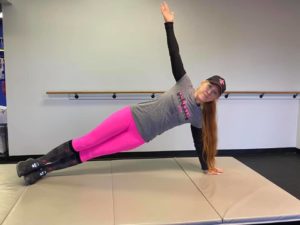
When it comes to core endurance, we often do high reps of crunches or bridges and call it a day. But the reality is our core works even while sitting, especially while standing and most importantly while moving. Thus an exercise that engages core muscles in functional positions or patterns of movement is more functional than one that isolates one section at the expense of others.
For example, taking the alternating bent over reverse fly (#14 of the article above), we see a long lever arm moving outward to the side as the trainee tries to stay parallel to the floor. Each subsequent movement by each arm applies a torque to the core that tries to bend and twist it. Doing multiple reps actually trains the core to stabilize for a long period of time, more so than if you do both arms at the same time. For one thing, the anti-rotation component doesn’t exist to the same degree in the bilateral move as it does in the unilateral. For another, assuming you can do the same number of reps with a particular weight whether bilateral or unilateral, the time under tension is longer for the alternating reverse fly; almost double if not more. (One could argue that you could even use a higher load as you have more rest between reps doing one arm at a time.)
Strength is the ability to apply force… or resist load. This entails lifting heavier weights in order to optimize one’s ability to apply a lot of force. Usually, this is measured as a function of %RM, or percentage of maximal repetition. That is, if you can curl 30# one time, that is your 1RM; if you can do it 10 times, it’s your 10RM. Thus, if you do 15# curls, you are training at 50% of your 1RM.
The other way to look at it is by how many reps you are able to do. If you can do more than 12, you are essentially training endurance as you are now working below 50% 1RM. It is recommended you lift at loads that actually fatigue you anywhere from 8 to 12 reps to get strong.
AT THE LOWER END OF REPS, YOU ARE GETTING STRONGER WHILE AT THE UPPER END YOU’RE CLOSING IN ON ENDURANCE.
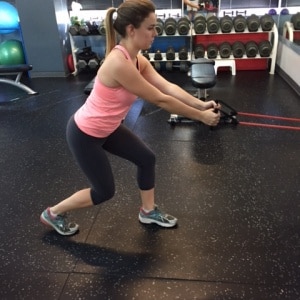
For the core, even though it’s just another muscle, the break point could endanger the spine so it’s usually not recommended to hit with high loads. That said, many exercises we do in the gym do actually involve the core at extremely high loads and never require isolating it. For example, a low-rep, high-load squat or power lift engages the core at extremely high load even though we tend to observe the legs or arm movements. But we could also do a standing cable row with a very heavy resistance which would fatigue the upper body in 8-12 reps but recognize that the core is also heavily challenged, making this an effective strength exercise for the core itself.
Power is the ability to produce lots of force quickly; it’s a function of speed but does not require actual speed. When the body tries to move quickly but the resistance prevents it, you’re engaging muscles, especially fast twitch, white fiber muscles, to produce speed, but the weight slows you down. Watch a powerlifter and you’ll note that he/she is hardly moving fast but is trying to do so with great effort. Now that’s power!
For core power, something as simple and basic as a squat and curl on the way up, assuming the resistance is greater than you could lift if you were simply standing or sitting down, would engage the core muscles rapidly in order to stiffen the spine. Likewise, a push-press, which is a shoulder overhead press performed off a partial squat, with speed, would constitute core power. The muscles that stabilize the lumbopelvic region would have to engage rapidly to propel the weights upward from the shoulder, then would have to contract isometrically very quickly to stabilize the spine against any backward bending resulting from the momentum of the weights from in front of the center line to on or behind it. If done with one arm, now you have to resist a lateral bending force on the core, too.
Finally, there’s speed, the ability to produce a high velocity movement. We know speed when we see it, in running, biking, etc. but in resistance training, we are often put off by it. The ability to move a light load very fast actually puts the joint in a dangerous position. Going back to the article, there are two exercises that should not be done fast: #4, the Good Morning, and #15, the Stability Ball Back Extension. I prefer to think of these as endurance exercises, maybe shifting into strength, but not power or speed.
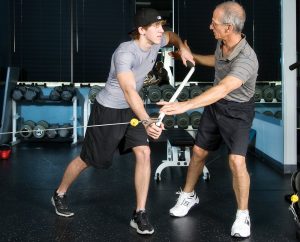
But how could we do a core exercise to simulate speed? My preference is for the tubing torso rotation, especially with a controlled stopping point. As this video shows, with a modest resistance, you can move quickly. However, I would suggest stopping at 45 degrees past the mid-point as the resistance declines rapidly beyond that; thus there’s no counterforce applied by the tubing as the spine approaches the terminus of the tissues themselves. Nonetheless, you can see how, with slightly more resistance and with a controlled end point, core speed could be trained here.
Which brings me to the end.
In sum, core training is not muscle-specific. It involves, includes, entails and integrates many of the muscles we associate with the core. It takes into account the various elements of muscle training, from activation to high speeds, from endurance to power. Core training does not require, in fact, I’d say it actually is violated, by isolation exercises except where the person’s initial status requires it.
CORE TRAINING IS NOT A FAD, NOR IS IT A SEPARATE PART OF A WORKOUT SESSION. IT CAN BE PART AND PARCEL TO ANY IF NOT ALL EXERCISES SIMPLY BY DOING THINGS ON ONE LEG, WITH ONE ARM, WITH RESISTANCES COMING FROM VARIOUS DIRECTIONS (GRAVITY-DOWN, CABLE OR TUBE -HORIZONTALLY OR DIAGONALLY).
Core is neither a fad nor a fashion, it is fundamental, and now you know why and what-for to take your training to the next level.
Originally printed on stepsfitness.com. Reprinted with permission. Images courtesy of STEPS Fitness.
Dr. Irv Rubenstein graduated Vanderbilt-Peabody in 1988 with a PhD in exercise science, having already co-founded STEPS Fitness, Inc. two years earlier — Tennessee’s first personal fitness training center. One of his goals was to foster the evolution of the then-fledgling field of personal training into a viable and mature profession, and has done so over the past 3 decades, teaching trainers across through country. As a writer and speaker, Dr. Irv has earned a national reputation as one who can answer the hard questions about exercise and fitness – not just the “how” but the “why”.

